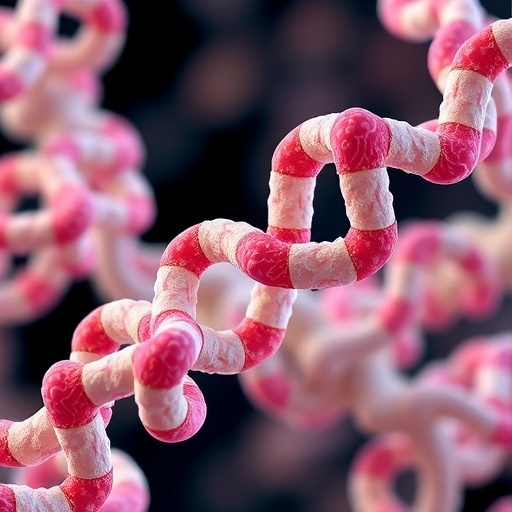In a groundbreaking advancement that promises to reshape the future of cancer immunotherapy, a research team helmed by Professor Ralf Jungmann has unveiled how the nanoscale organization of cellular receptors dictates the function of therapeutic antibodies. Published recently in the prestigious journal Nature Communications, this study leverages an innovative super-resolution imaging method to expose, with unprecedented clarity, the intimate dance between antibodies and their receptor targets on cancer cells. This breakthrough fundamentally enhances our understanding of antibody mechanisms and paves the way for the design of next-generation immunotherapies with heightened precision and efficacy.
Therapeutic antibodies have been at the forefront of cancer treatment paradigms for over two decades, revolutionizing patient outcomes by harnessing the immune system’s power to attack malignant cells. Yet, despite their widespread use and clinical success, the precise molecular underpinnings that govern their therapeutic effectiveness have remained partially obscured. Much of this mystery has stemmed from the technical limitations inherent in studying antibody-receptor interactions at the nanoscale within living cells. Traditional imaging techniques have fallen short of resolving the complex receptor architectures that dictate functional antibody responses.
Addressing this critical gap, Jungmann’s team applied a novel microscopy technique named Resolution Enhancement by Sequential Imaging, or RESI. This cutting-edge approach enables visualization of single protein molecules on the cellular membrane with sub-nanometer resolution, a feat previously unattainable in intact cellular environments. By sequentially imaging orthogonally barcoded receptors and antibodies, RESI dissects their spatial arrangements with exquisite detail, revealing patterns that directly correspond to distinct therapeutic outcomes.
The focal point of their study was the CD20 receptor, a well-known therapeutic target expressed on B cells and implicated in various lymphomas and leukemias. Using high-throughput multi-target 3D RESI imaging, researchers meticulously mapped the nanoscale architecture of CD20 molecules and their complexes with two widely used anti-CD20 antibodies, Rituximab and Obinutuzumab. These antibodies differ subtly in their molecular design and clinical effects, yet until now, the structural basis of these differences remained elusive.
What emerged from their detailed imaging was a striking revelation: the way antibodies reorganize CD20 receptors on the cell surface dictates their downstream immune activation and tumor cell killing. Rather than simply binding receptors statically, therapeutic antibodies induce dynamic rearrangements, forming distinct nanoscale assemblies that influence signaling pathways and immune effector functions. This discovery challenges the prevailing simplistic models of antibody action and points to receptor pattern formation as a key determinant of therapeutic potency.
Isabelle Pachmayr, lead author of the study, articulates the transformative potential of these findings: “For the first time, we can directly visualize how structural modifications in antibody design translate into specific receptor clustering patterns and the resultant cellular responses. This insight provides a rational blueprint for engineering antibodies that elicit optimized therapeutic functions.” Her words underscore how molecular-level visualization bridges the gap between antibody structure and biological effect with unprecedented fidelity.
Beyond the compelling insights into CD20, this research heralds a new era of antibody biology by demonstrating the versatility and scalability of RESI technology. Unlike cryo-electron microscopy, which, while highly detailed, is labor-intensive and restricted to static, often non-physiological conditions, RESI operates in intact, living cells. This capability permits longitudinal studies of receptor dynamics and antibody effects in a context that closely mirrors the in vivo environment, vastly expanding the horizons of drug discovery.
The implications extend well beyond cancer immunotherapy. Because RESI can label and resolve virtually any membrane receptor with molecular specificity, it offers a powerful platform to interrogate a broad spectrum of therapeutic antibodies and receptor systems involved in autoimmune diseases, infectious diseases, and neurological disorders. The ability to map receptors and antibody interactions in three dimensions with sub-nanometer precision opens novel investigative pathways previously inaccessible.
Looking forward, the team envisions integrating RESI with multiplexed imaging of intracellular signaling molecules to construct comprehensive maps of immune activation cascades at the single-molecule level. This integrative approach promises to unravel complex therapeutic pathways, enabling scientists to pinpoint crucial molecular checkpoints and design therapies tailored to modulate these with exquisite accuracy.
Professor Jungmann reflects on this paradigm shift: “RESI unites structural biology with cellular physiology, providing a real-time window into the nanoscopic world where therapeutic outcomes are decided. This represents a quantum leap in our capacity to rationally design antibodies that can more effectively harness the immune system against cancer.” His statement encapsulates the transformative potential of this technology for immunotherapy research.
In sum, the innovative use of RESI imaging by Jungmann and colleagues breaks new ground in visualizing the elusive nanoscale mechanisms that underlie antibody function. By revealing how receptor organization within living cells governs the therapeutic activity of antibodies, this study charts a clear path toward engineering superior immunotherapies. As research continues to build on these findings, RESI may well become an indispensable tool in the global quest to develop more precise and potent treatments for cancer and beyond.
Subject of Research: The molecular and nanoscale organization of therapeutic antibody-receptor complexes in cancer immunotherapy using super-resolution imaging.
Article Title: Resolving the structural basis of therapeutic antibody function in cancer immunotherapy with RESI
News Publication Date: 23-Jul-2025




